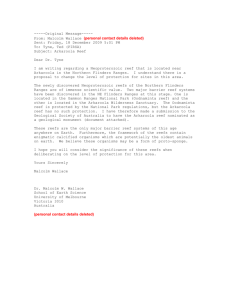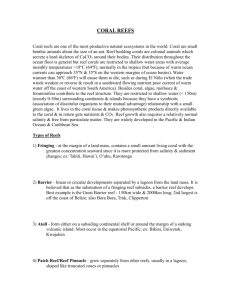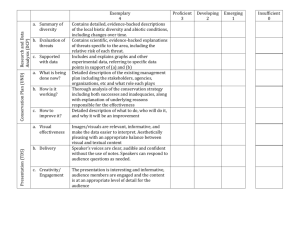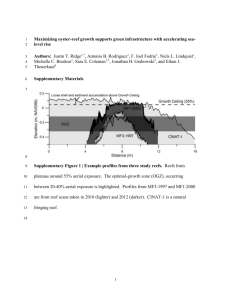Limestone part 5
advertisement
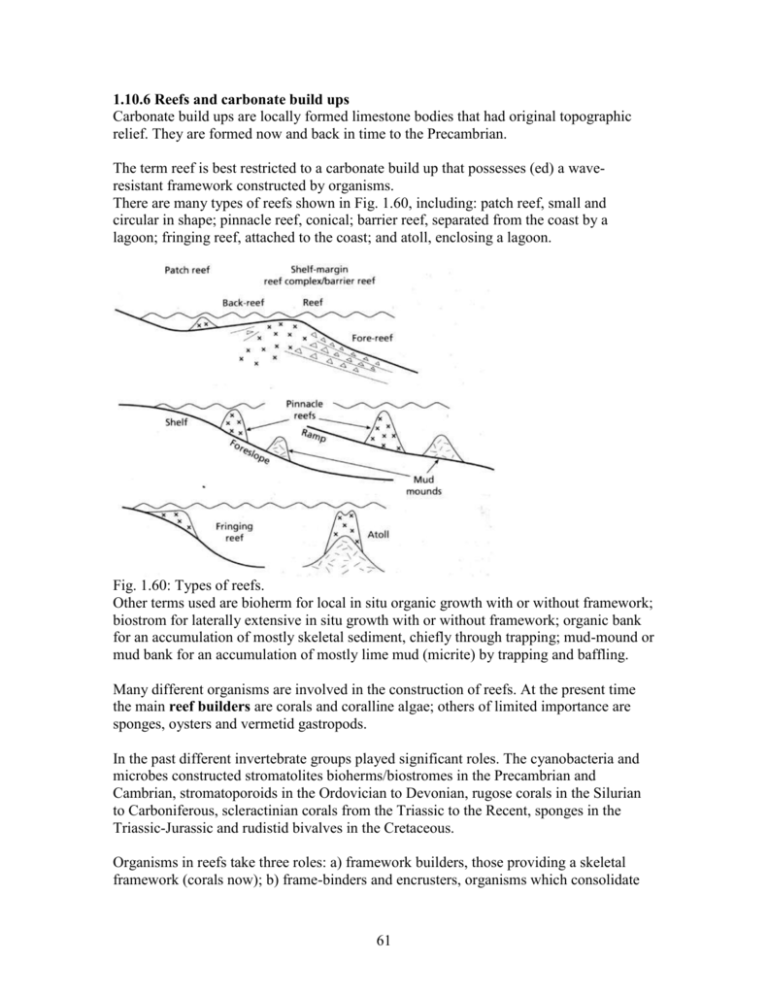
1.10.6 Reefs and carbonate build ups Carbonate build ups are locally formed limestone bodies that had original topographic relief. They are formed now and back in time to the Precambrian. The term reef is best restricted to a carbonate build up that possesses (ed) a waveresistant framework constructed by organisms. There are many types of reefs shown in Fig. 1.60, including: patch reef, small and circular in shape; pinnacle reef, conical; barrier reef, separated from the coast by a lagoon; fringing reef, attached to the coast; and atoll, enclosing a lagoon. Fig. 1.60: Types of reefs. Other terms used are bioherm for local in situ organic growth with or without framework; biostrom for laterally extensive in situ growth with or without framework; organic bank for an accumulation of mostly skeletal sediment, chiefly through trapping; mud-mound or mud bank for an accumulation of mostly lime mud (micrite) by trapping and baffling. Many different organisms are involved in the construction of reefs. At the present time the main reef builders are corals and coralline algae; others of limited importance are sponges, oysters and vermetid gastropods. In the past different invertebrate groups played significant roles. The cyanobacteria and microbes constructed stromatolites bioherms/biostromes in the Precambrian and Cambrian, stromatoporoids in the Ordovician to Devonian, rugose corals in the Silurian to Carboniferous, scleractinian corals from the Triassic to the Recent, sponges in the Triassic-Jurassic and rudistid bivalves in the Cretaceous. Organisms in reefs take three roles: a) framework builders, those providing a skeletal framework (corals now); b) frame-binders and encrusters, organisms which consolidate 61 the framework, such as calcareous algae and bryozoans; and c) reef-users, such as boring bivalves and sponges, predatory fish and echinoderms. Reef limestones have two typical features: a massive appearance with no stratification, and presence of the organisms in growth position. Present coral reefs are controlled by the following factors: 1- water temperature: optimum growth occurs around 25ºC; 2- water depth: most growth takes place within 10 m of the surface; 3- salinity: corals cannot tolerate great fluctuations; 4- turbidity and wave action: coral growth is favored by intensive wave action and an absence of terrigenous silt and clay. Many modern reefs along shelf margins can be divided into three parts: for reef (reef front/slope), the reef itself (reef-crest, reef flat) and back-reef. The reef front is a steep slope, with organisms constructing reef in the upper part, passing down to a talus slope of coarse reef debris. The reef crest, covered by no more than 1-2 m of water, is the site of prolific organic growth, of corals and algae on modern reefs. Behind the crest is the reef flat, a pavement of mostly dead corals. The back reef area consists of reef debris adjacent to the reef flat, passing shoreward to a quiet water lagoon, where there may be patch reef. Reefs are important hydrocarbon reservoirs with the most porous facies generally occurring in the upper fore-reef and reef-framework facies if not marine cemented. The talus at the toe of reef slopes also makes good reservoirs. Many reefs are dolomitized which enhances their reservoir qualities. 1.10.7 Pelagic limestones If water depth is too great for benthic organisms to flourish, in excess of 50-100 m, then carbonate sediments composed of pelagic organisms will accumulate in the absence of terrigenous clays. Pelagic carbonates occur to a depth referred to as the carbonate compensational depth (CCD), where below it the carbonates are dissolved. This carbonate dissolution is due to low temperature of water which increases solution of CO2, thus water becomes undersaturated with respect to aragonite and calcite that causes their dissolution. Above the CCD which varies in tropical water from 4500 to 5000 m to calcite, and from 2500 to 3000 m to aragonite, calcareous oozes accumulate on the ocean floor. Below CCD siliceous oozes and red clays are present. Modern pelagic carbonates are composed of pteropods (aragonitic), coccoliths and foraminifers (both calcite), and are found on outer continental shelves, continental slopes 62 and ocean floors starved of terrigenous clay, and on submarine rises, drowned reefs and volcanoes (sea mounts and guyots) rising from the ocean floor. Ancient pelagic limestones are common in the Devonian and Carboniferous of Hercynian Europe, and many Mesozoic deposits, such as the Cretaceous chalks of northwest Europe and southern USA. Besides pelagic fauna, pelagic limestones are characterized by their condensed nature and evidence for synsedimentary cementation in the form of hardgrounds, lithoclasts, sheet cracks and Neptunian dikes, nodular-like appearance, and presence of frromagnesian nodules and crusts. 63

